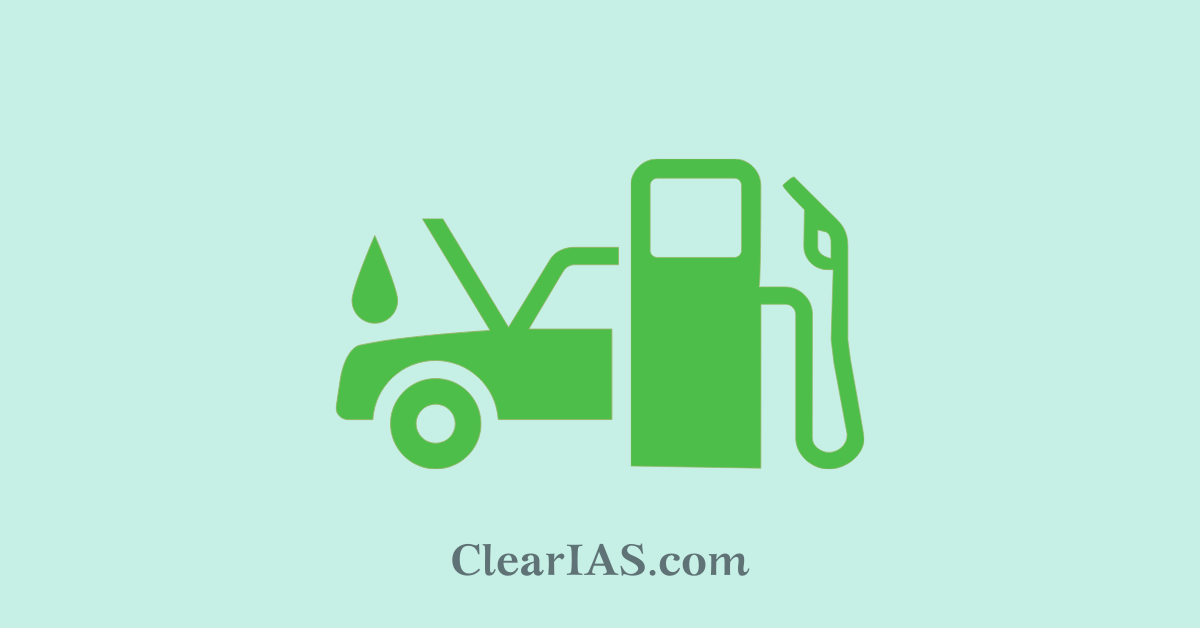
What are flex-fuel vehicles? What are BS-6 norms? Why is the Indian government promoting flex-fuel vehicles? Know more here.
Indian Minister for Road Transport and Highways has asked automobile manufacturers to manufacture flex-fuel vehicles complying with BS-6 norms within six months.
The government has also advised carmakers to start making Flex Fuel Strong Hybrid Electric Vehicles (FFSHEV).
When FFV is integrated along with strong hybrid electric technology, it is referred to as FFV-SHEVs.
What are flex-fuel vehicles?
Flexible fuel vehicles (FFVs) have an internal combustion engine and are capable of operating on gasoline and any blend of gasoline and ethanol.
FFVs are capable of running on 100 percent petrol 100 percent bio-ethanol or a combination of both.
Key features and aspects related to flex-fuel vehicles:
- Ethanol Flexibility: FFVs are capable of using gasoline, ethanol, or a blend of both. This flexibility allows drivers to choose the fuel based on availability, cost, and environmental considerations.
- E85 Fuel Blend: E85 is the most common flex-fuel blend, consisting of 85% ethanol and 15% gasoline. It is a renewable fuel derived from plant materials, often corn or sugarcane.
- Fuel Composition Sensors: FFVs are equipped with fuel composition sensors that can detect the ethanol content in the fuel. Based on this information, the engine control module adjusts parameters to optimize performance.
- Wide Ethanol Range: FFVs can typically operate on fuel blends containing up to 85% ethanol. This wide range allows for the utilization of various ethanol-gasoline blends available in the market.
- Reduced Greenhouse Gas Emissions: Ethanol is considered a cleaner-burning fuel compared to conventional gasoline, and the use of E85 in FFVs can contribute to a reduction in greenhouse gas emissions.
- Government Incentives: In some countries, governments may provide incentives to promote the use of biofuels, including flex-fuel vehicles. These incentives can include tax credits, subsidies, or other advantages for consumers and manufacturers.
- Market Availability: Many major automakers produce flex-fuel vehicles, offering consumers a range of options in terms of vehicle types and models. These vehicles are often labeled as “Flex-Fuel” or may carry an “FFV” badge.
- Fuel Economy Variability: The fuel efficiency of FFVs can vary depending on the ethanol content in the fuel. E85 typically has a lower energy content than gasoline, leading to reduced fuel efficiency when using higher ethanol blends.
Various countries around the world, particularly those with significant agricultural production, have promoted the use of biofuels like ethanol as part of their efforts to reduce dependence on fossil fuels and mitigate environmental impact.
Strong Hybrid (Full Hybrid) Vehicles
Strong hybrid is another term for full hybrid vehicles, which can run solely on either electric or petrol modes. In contrast, mild hybrids cannot run purely on one of these modes and use the secondary mode merely as a supplement to the main mode of propulsion.
Characteristics of Strong Hybrid Vehicles are:
- Electric-Only Operation: Strong hybrids can operate on electric power alone for short distances and at low speeds. This is particularly useful in urban driving conditions, where the vehicle can run silently and emit zero tailpipe emissions.
- Regenerative Braking: Like mild hybrids, strong hybrids utilize regenerative braking systems to capture and store energy during braking. This stored energy is then used to assist in propulsion or power electrical accessories.
- Significant Fuel Efficiency Improvement: Strong hybrids offer a more substantial improvement in fuel efficiency compared to mild hybrids. The electric motor can assist the internal combustion engine during acceleration, reducing the overall fuel consumption of the vehicle.
- Higher Electric Power and Speed Capabilities: Strong hybrids can achieve higher speeds in electric-only mode compared to mild hybrids. This is achieved through larger and more powerful electric motors and higher-capacity batteries.
- Automatic Engine Start/Stop: Like mild hybrids, strong hybrids often feature automatic engine start/stop systems. The internal combustion engine shuts off when the vehicle is stationary, and the electric motor provides power during idling.
BS-VI Fuel Norms
The Bharat Stage (BS) is the mission standard instituted by the Government of India to regulate the output of air pollutants from motor vehicles.
India directly shifted from BS-IV to BS-VI norms which were to happen in 2022 but due to the poor air condition, the move was advanced by four years.
Difference between BS-VI and IV:
- In BS-VI fuel, the volume of particulate matter 2.5 ranges from 20 to 40 micrograms per cubic meter whereas in BS-IV fuel it is up to 120 micrograms per cubic meter.
- BS-VI fuel will bring down sulfur content by 5 times from the current BS-IV levels. It has 10 ppm of sulfur as against 50 ppm in BS-IV.
- With BS-VI fuel, for every kilometer, a car will emit 80% less particulate matter and nearly 70% less nitrogen oxide.
- Air pollutants in BS-VI fuel are much less as compared to BS-IV fuel.
BS-VI norms also seek to reduce the level of certain harmful hydrocarbons in the emissions that are produced due to incomplete combustion of fuel.
Why is the government of India pushing for Flex Fuel Vehicles?
India’s oil import bill stood at $62.7 billion in FY21, which was matched in just the first seven months (April-October) of this year.
To pile on the stress, the rupee is at its weakest level in the last three financial years. Hence, the government is desperate to bring down the oil import bill by creating fuel substitutes like ethanol, hydrogen, and electricity.
This is possible only if flex-fuel vehicles are made available in the market. Also, FFVs will help the government meet its commitments when it comes to reducing emissions.
A liter of petrol sold in India has an average of 8 percent ethanol content even though oil marketing companies have clearance to do even 10 percent (E10) blending.
To accelerate the introduction of Flex Fuel Vehicles, the PLI scheme has included automobile and auto components of flex-fuel engines.
The use of ethanol or methanol as fuel will lead to the creation of an additional revenue stream for farmers. This will provide direct benefits to farmers and help in doubling their income.
It is also in line with the Prime Minister’s vision of Atma Nirbhar Bharat and the government’s policy on promoting ethanol as a transport fuel.
Adopting this will help to reduce greenhouse gas emissions from vehicles on a well-to-wheel basis hence helping India to comply with its commitment made at COP26 to reduce the total projected carbon emissions by one billion tonnes by 2030.
Ethanol blending
- E10 is a low-level blend composed of 10% ethanol and 90% gasoline
- E15 is a low-level blend composed of 10.5% to 15% ethanol and gasoline.
- E85 (or flex fuel) is an ethanol-gasoline blend containing 51% to 83% ethanol,
All vehicles manufactured in India are tuned for E10.
To what extent will FFVs help in cutting emissions?
According to a report by the expert committee formed by the Ministry of Petroleum and Natural Gas, by just hitting E20, carbon monoxide emissions were observed to be 50 percent lower in two-wheelers and 30 percent lower in four-wheelers compared to petrol.
Hydrocarbons were lower by 20 percent. The report also mentioned that E20 blending will result in a drop in fuel efficiency by nearly 6-7 percent in 4-wheelers designed for E0 and calibrated to E10.
What has been the auto industry’s reaction to Flex Fuel Vehicles?
The higher blending of ethanol will mean higher manufacturing costs which translate to pricier vehicles.
Certain auto parts, especially those that come in contact with higher ethanol content, will have to be replaced with a compatible product to avoid corrosion.
Automotive companies say that they are ready to move with government regulations on ethanol blending of E20 by 2025.
Conclusion
Flex fuel vehicles represent one of the strategies for diversifying the transportation fuel mix and reducing the environmental footprint of the automotive sector. While challenges exist, ongoing advancements in biofuel technology and increasing awareness of sustainable transportation options contribute to the continued development and adoption of flex-fuel vehicles.
Read:






Leave a Reply